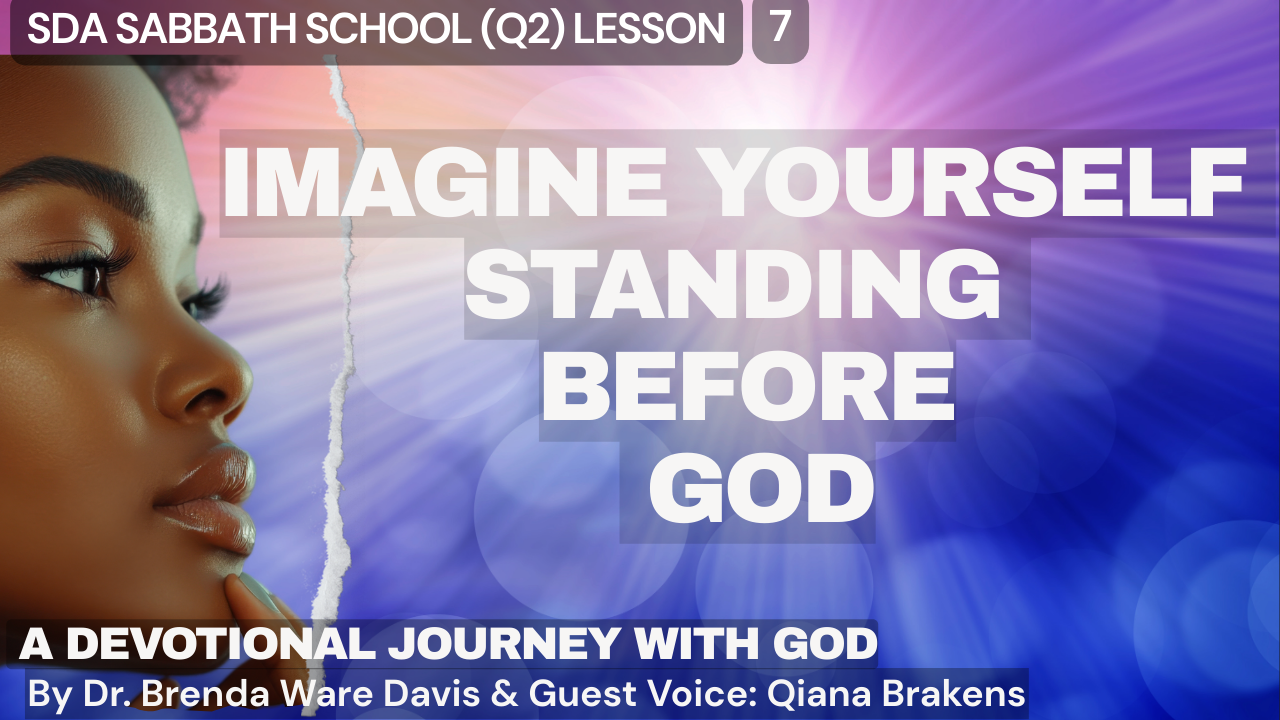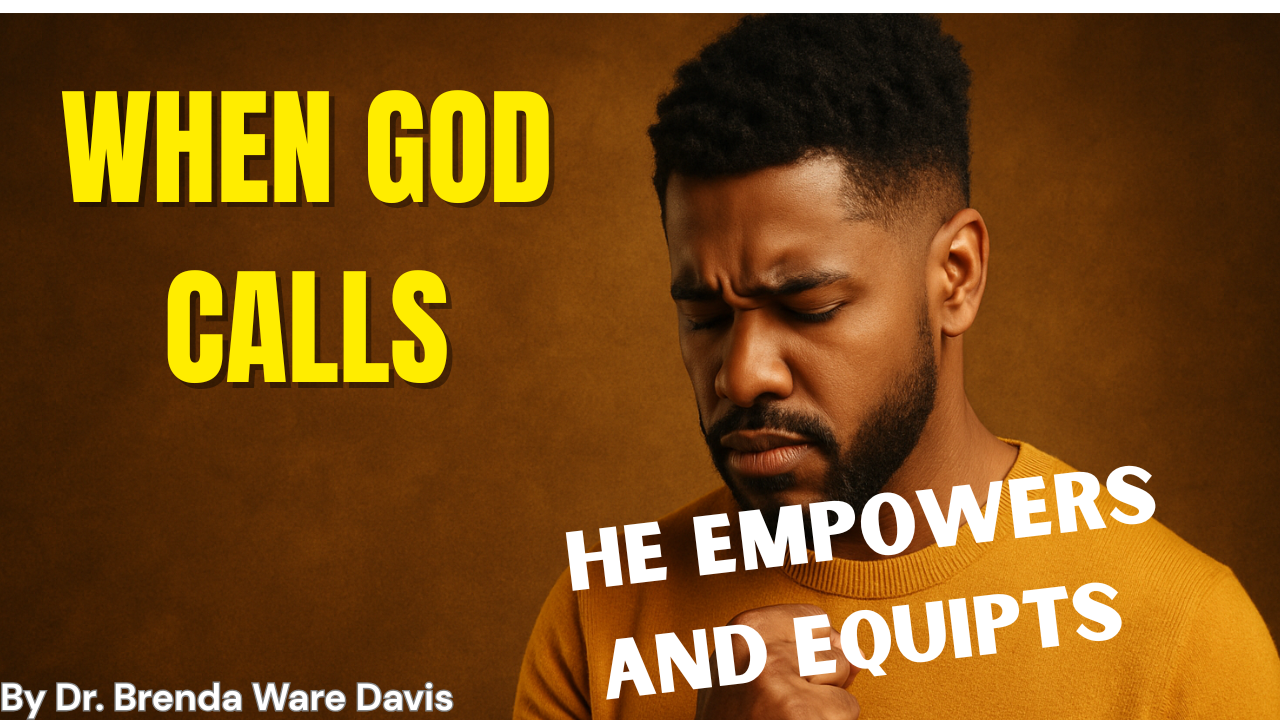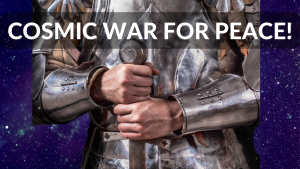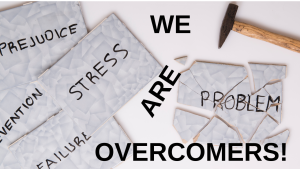2nd Qtr
Sabbath School Lesson 2025
Amazing Love of God, Ark of the Covenant, Bible Study for Beginners, Cherubim, Faith and Forgiveness, Faith That Heals Relationships, Living Creatures, Sabbath School for Adults, SDA Sabbath School, Spiritual Growth Videos, Spiritual Lessons on Love, YouTube Sabbath School
Dr. Brenda Davis PhD
0 Comments
Allusions, Images, Symbols: How to Study Bible Prophecy (Lesson 7) Foundation of Prophesy
IMAGINE YOURSELF STANDING FACE TO FACE WITH GOD…
Have you ever wondered what it would be like to stand in the presence of God? 😮
To hear His voice?
Welcome back to episode 7 of our 13-part series on understanding the past, the present and the future using the Bible as our guide.
We are about to take a journey into the throne room of Heaven. Stay with us, for this could be the trip of a lifetime.
The Bible provides the keys needed to understand what it really means live in the presence of God.
In this series, we explore Bible stories, symbols, and signs to help us know and understand how to live now to prepare for our future life in eternity.
These stories, symbols, and signs are the foundational keys to unlocking the special message God has for our day that can bring a change personally, spiritually and emotionally to our lives.
So, keep watching.
But, before we begin, Let’s Pray.
Allusions, Images, Symbols: How to Study Bible Prophecy
(Lesson 7)
Foundation of Prophesy
Part 1 Introduction
Standing in God’s presence changes everything.
It shows us who we are—but more importantly—it shows us who He is.
So much so that when the prophet Isaiah stood before God’s throne, he didn’t just see power—he heard purpose.
God was calling for someone to represent Him.
And Isaiah in Isaiah 6:8 answered with courage: “Send me!”
His response came from a heart that was no longer filled with selfishness and pride but transformed with humility and empowered by the Spirit of God.
That’s why he could say:
Also, I heard the voice of the Lord, saying: ‘Whom shall I send, and who will go for Us?’ Then I said, ‘Here am I! Send me’” (Isaiah 6:8, NKJV).
God rules the universe—not because He forced His way in.
He is the ruler of the universe because he created everything.
That why it says in Revelation 4:11
11 “You are worthy, O Lord, To receive glory and honor and power; For You created all things, And by Your will they exist and were created.” (Revelation 4:11)
God deserves our praise because everything that lives owe its breath to Him.
He made it all. You. Me. The stars. The air. He holds it all together.
But there’s something more—something deeper—that gives God the right to rule the universe.
It’s not just His power. It’s His character. When we come close to Him, we begin to see the truth about ourselves. We recognize our spiritual condition.
“For all have sinned and fall short of the glory of God” (Romans 3:23).
None of us measure up. We all have messed up. Only God is perfect.
But the beauty of it all is that He doesn’t leave us stuck in our brokenness.
In this lesson we take a deeper look into that heavenly throne room.
Through the vision of God’s prophet, we enter the presence of God.
We’ll see not only where God sits—but how He relates to us fallen human beings.
Even though we’re sinful, God is working to bring us closer to His throne.
In line with this we see how the sacrifice of Christ restores us and brings us close to His throne.
In fact, He doesn’t just want to fix us as individuals.
He wants to heal the human race. He wants us to live eternally with him 🌎
He wants us to shine again—to reflect His character and show His beauty to the rest of His creation.
To understand better, we search the Bible.
That’s where we find clues—clues about who we are, why we’re here, and the amazing mission God has called us to as a race of forgiven and redeemed sinners who have been forgiven.
It may not seem possible, but one day, all rebellion—every act of hate, pride, and selfishness—will be gone forever.
God is going to bring it all to an end.
But what’s even more amazing is this: God’s love, His self-denying and self-sacrificing character, will shine brighter than it ever has before, even brighter than it did in His original creation of humanity.
Though God did not intend for us to fall into sin, because the Cross, because of Jesus’ sacrifice, God’s true loving nature has been revealed more clearly than ever before.
Standing in God’s presence changes everything.
It shows us who we are—but more importantly—it shows us who He is.
Isaiah had the experience of having a stunning vision of God’s throne.
Recognizing his condition, he cried out, “Woe is me.”
Why is the outcome of his meeting significant to us today?
Read Isaiah 6:1-8. Share your thoughts in the comment section. Then continue to Part 2: Here I Am Send Me
Allusions, Images, Symbols: How to Study Bible Prophecy
(Lesson 7)
Foundations for Prophesy
Part 2: Here I Am, Send Me
What happens when God turns the light on in our lives?
What do we see when we stand before Him.
When God shines his light on us, we do not see ourselves as we think we are, but as we really are.
But even in our darkest moments, God doesn’t turn from us, He extends His arms of love toward us.
The story is told of a church that decided to renovate an old, worn-out basement.
They wanted to turn it into a beautiful fellowship hall where they could socialize with each other.
One of the first upgrades was new lighting.
They thought the bright lights would make the space look better, more refreshing and inviting.
But when the lights were installed, the opposite happened.
Instead of hiding the flaws, the bright light showed every crack, every stain, every imperfection.
That’s what light does, it exposes things we don’t want to see.
That’s what happened to Isaiah. He had a stunning vision of God’s throne.
But the beauty of the throne wasn’t the only thing that left him speechless.
It was how clearly, he saw himself in that light.
How he saw himself and the light left him painfully aware of his shortcomings. So much so, He cried,
“Woe is me, for I am undone! Because I am a man of unclean lips, and I dwell in the midst of a people of unclean lips; for my eyes have seen the King, the Lord of hosts” (Isaiah 6:5, NKJV).
In God’s presence, Isaiah didn’t feel strong or proud—he felt broken.
That’s what God’s holiness does. It shows us who we really are.
If you or I were suddenly taken into God’s throne room, we would feel the same.
The brightness of His glory removes every excuse.
In his radiant light, we can’t pretend.
We can only say what Isaiah said: “I am undone.”
In God’s presence, we sense that we are lost and in a state of hopelessness in our present condition.
But Isaiah was about to experience something he never expected.
Isaiah recognized his sinful conditions.
He knew that the payment for sin is death.
But God, instead of leaving us to the consequences of our sins, God reaches out his loving arms and pulls us closer to Him.
So, what happened next.
Isaiah 6:6-8
6 Then one of the seraphim flew to me, having in his hand a live coal which he had taken with the tongs from the altar.
7 And he touched my mouth with it, and said: “Behold, this has touched your lips; Your iniquity is taken away, And your sin purged.”
8 Also I heard the voice of the Lord, saying: “Whom shall I send, And who will go for Us?” Then I said, “Here am I! Send me.” (Isaiah 6:6–8).
You see, Isaiah knew he was a sinner.
He knew sin brings death.
But instead of pushing Isaiah away, God sent a heavenly being to purge his sin and make him clean.
That’s grace. That’s love.
The coal touched Isaiah’s lips came from the altar—most likely the altar of incense, where prayers were lifted up for God’s people as in Revelation 8:3-4.
3 Then another angel, having a golden censer, came and stood at the altar. He was given much incense, that he should offer it with the prayers of all the saints upon the golden altar which was before the throne.
4 And the smoke of the incense, with the prayers of the saints, ascended before God from the angel’s hand. (Revelation 8:3–4).
This altar was a place of intercession—a place where heaven and earth connected.
God was telling Isaiah, your sins are forgiven, they are gone.
You are now fit to stand in my presences. But more than that, he was called to go and represent God to the world.
Thus, Isaiah wasn’t just forgiven. He was commissioned. He was sent to go tell the world.
Here’s something powerful to remember: the angel that touched Isaiah’s lips was a seraph.
And the word seraph means “the burning one.”
Now think about this—Jesus described John the Baptist in John 5:35 like this:
“He was the burning and shining lamp, and you were willing for a time to rejoice in his light” (John 5:35).
Now, John, though still a sinner in need of grace, was called a burning light—in Jesus, He could be like a seraph letting people know that Jesus is the only one who brings grace and salvation to all humanity.
That means God can use broken people to carry His light to the world.
Jesus Himself is the perfect light—the exact image of God’s glory.
But He still sends broken human messengers—like Isaiah, like John, like us—to shine that light in a dark world.
Thus, God sent a prophet, a sinner, to perform a task similar to one of heaven’s seraphim.
Once Isaiah new he had received full pardon of his sins, He could only say, “Here am I! Send me,” (Isaiah 6:8).
That’s how it works. Once we know we’re forgiven, once we feel God’s mercy for ourselves, we don’t just want to stand in His presence—we want to go out tell it to the world.
So, how about you?
Has your heart been touched by the grace of God?
Have your sins been purged by the blood of Jesus?
Then maybe it’s time to say what Isaiah said: “Here am I. Send me.”
Though we may not feel ready.
Though we may still see our flaws.
But, If God can use Isaiah… if He can use John… He can use you.
When Adam and Eve were evicted from the garden of Eden, at the entrance gate to the garden, God place two cherubim with a brilliant flashing light between them.
Though it was their job to keep sinful beings from accessing the tree of life, they also symbolized something.
What do you suppose they symbolize?
Read Genesis 3:15-24. Share what you think. Place it in the comment section.
Bottom of Form
Then, View the next segment of this video, Part 3: The Two Cherubim
Allusions, Images, Symbols: How to Study Bible Prophecy
(Lesson 7)
Foundation of Prophesy
Part 3: The Two Cherubim
What if the first evidence of God’s presence after sin wasn’t just about judgment—but hope?
What if right outside the gates of Eden, God left behind a message that one day, everything lost would be restored?
We go back to the beginning to find out what it really meant to stand in His presence of God—even after we fall.
Even though Adam and Eve were evicted from the Garden, God didn’t leave them without hope.
Right there in the pain of their failure, in Genesis 3:15, He gave them a promise. He offered them the hope of a coming Messiah saying:
“And I will put enmity between you and the woman, and between your seed and her Seed; He shall bruise your head, and you shall bruise His heel” (Genesis 3:15).
This is the very first promise of the Messiah.
God said a Savior would come born of a woman who would crush the head of the serpent, Satan.
So, even in their failure, God was planting the seed of redemption.
But God didn’t stop with words. He gave them a powerful symbol to hold onto.
Right at the entrance gates of Eden, He placed two cherubim. Between them flashed a brilliant, fiery light.
This image should sound familiar—because it’s almost exactly like the ark of the covenant, which is a sacred symbol of God’s throne as revealed in Genesis 25:18
“And you shall make two cherubim of gold; of hammered work you shall make them at the two ends of the mercy seat” (Exodus 25:18).
The ark was where God’s presence dwelt—between the cherubim.
The same image God left at Eden’s gate is a reminder that even outside the Garden, His presence is there still reaching out to us.
So, though the cherubim had responsibility to keep sinners from accessing the tree of life, they were also a symbol of hope, of promise, that one day we humans would be restored to Paradise.
Genesis 3:21-24 says
21 Also for Adam and his wife the Lord God made tunics of skin, and clothed them.
22 Then the Lord God said, “Behold, the man has become like one of Us, to know good and evil. And now, lest he put out his hand and take also of the tree of life, and eat, and live forever”— 23 therefore the Lord God sent him out of the garden of Eden to till the ground from which he was taken.
24 So He drove out the man; and He placed cherubim at the east of the garden of Eden, and a flaming sword which turned every way, to guard the way to the tree of life. (Genesis 3:21–24).
So, yes, the cherubim were there to block the way to the Tree of Life, But they also stood as a symbol of hope.
They reminded humanity that this wasn’t the end.
Ellen White puts it beautifully: saying in Patriarchs and Prophets
“The Garden of Eden remained upon the earth long after man had become an outcast from its pleasant paths. The fallen race was long permitted to gaze upon the home of innocence, their entrance barred only by the watching angels. At the cherubim-guarded gate of Paradise the divine glory was revealed. Hither came Adam and his sons to worship God. Here they renewed their vows of obedience to that law the transgression of which had banished them from Eden. . . . But in the final restitution, when there shall be ‘a new heaven and a new earth’ (Revelation 21:1), it is to be restored more gloriously adorned than at the beginning.”—Patriarchs and Prophets, p. 62.
Now, there is something really interesting in Genesis 3:24.
The Bible says God “placed” the cherubim at the gate.
But the Hebrew word for “placed” is shakan, the same root word for tabernacle—the place where God’s presence lived among His people.
Notice what it says in Genesis 25:9
9 According to all that I show you, that is, the pattern of the tabernacle and the pattern of all its furnishings, just so you shall make it. (Exodus 25:9, NKJV).
And Numbers 3:26
26 the screen for the door of the court, the hangings of the court which are around the tabernacle and the altar, and their cords, according to all the work relating to them. (Numbers 3:26).
Even though it’s not found in the Bible, the word “Shekinah” is often used to talk about God’s presence.
It comes from a Hebrew word that means “to live” or “to stay.”
This word is also used to describe how God placed angels, called cherubim, at the east side of the Garden of Eden.
It could be said that “God made His home with the cherubim at the garden’s entrance.”
In other words, God didn’t just put angels at the gate, He tabernacled there.
He lived with them. His presence stayed with humanity—even outside of Eden.
In the Bible, cherubim are always tied to God’s presence.
This is evident when we read 1 Chronicles 13:6, Psalms 80:1, and Isaiah 37:16.
Isaiah 37:16 says:
“O Lord of hosts, God of Israel, the One who dwells between the cherubim, You are God, You alone, of all the kingdoms of the earth” (Isaiah 37:16).
Again and again, we see this picture: God dwelling between the cherubim.
His throne is holy, but it’s also full of mercy and grace.
Moreover, in the book of Revelation, we see 24 elders around that throne, lifting up their voices in worship in Revelation 4 and 5.
What are they saying?
Revelation 4:11
11 “You are worthy, O Lord, To receive glory and honor and power; For You created all things, And by Your will they exist and were created.” (Revelation 4:11)
Eden will be restored!
“…Paradise lost will be paradise restored. God’s plan for the redemption of man will be complete. The Son of Man will bestow upon the righteous the crown of everlasting life, and they shall “serve him day and night in his temple; and he that sitteth on the throne shall dwell among them. They shall hunger no more, neither thirst any more; neither shall the sun light on them, nor any heat. For the Lamb which is in the midst of the throne shall feed them, and shall lead them unto living fountains of waters: and God shall wipe away all tears from their eyes.”—“The First and Second Advent,” Advent Review and Sabbath Herald, September 5, 1899, par. 15
What will it be like to stand in God’s presence. The Cherubim must know, because they seem to always be around God’s throne. They apparently are not there for decorations. Who are they and what do they do?
Read Ezekiel 1:4–14, Isaiah 6:1–6 Revelation 4:1–11. Share what you think. Then, Continue to the next segment of this video, Part 4: Like Burning Coals of Fire
Allusions, Images, Symbols: How to Study Bible Prophecy
Foundation of Prophesy
Part 4: Like Burning Coals of Fire
What would it be like to stand before the throne of God?
To see His glory.
To feel His power.
To know, in that moment, who He really is—and who we really are.
The Bible gives us a glimpse.
It’s more than just a vision.
It’s a message for every one of us.
Let’s go back.
Let’s look again at these Cherubim who stand in God’s presence.
Cherubim are not just decorations in the Bible.
They are real, living creatures.
They show up all over the Old Testament.
Sometimes, they move. Sometimes, they stand still.
But they are always close to God’s throne.
Ezekiel chapter 10: 8 says:
“The cherubim appeared to have the form of a man’s hand under their wings.”
That means Cherubim are living beings that:
Were created by God.
Are Obedient to His will.
They are often depicted as standing near God’s throne, radiating His glory to the universe.
In the Old Testament, according to Exodus 25:18-25 symbolizing the living cherubim, cherubim of gold were placed in the most Holy Place, one on each end of the mercy seat.
Exodus 25:18
19 Make one cherub at one end, and the other cherub at the other end; you shall make the cherubim at the two ends of it of one piece with the mercy seat.
20 And the cherubim shall stretch out their wings above, covering the mercy seat with their wings, and they shall face one another; the faces of the cherubim shall be toward the mercy seat. (Exodus 25:18–20).
Though symbols the arch of the covenant was considered holy.
It was to be covered by two solid golden cherubim.
One was to be placed on one end.
The other was to be placed on the opposite end.
Their wings were to extend toward one another.
God presence rested between them.
God also instructed the Israelites in Exodus 26:1 to have cherubim woven into the curtain of the temple.
Exodus 26:1
1 “Moreover you shall make the tabernacle with ten curtains of fine woven linen and blue, purple, and scarlet thread; with artistic designs of cherubim, you shall weave them. (Exodus 26:1)
That curtain was between the Holy Place and the Most Holy Place.
Behind the curtain was God’s glory.
Then we get this beautiful picture from the book of Psalms of God”s closeness to the cherubim.
Psalm 18:10
“He rode upon a cherub and flew; He flew upon the wings of the wind.” (Psalm 18:10)
What a picture of power.
God, riding above the earth.
Swift! Majestic! Holy!
Now let’s hear from Ezekiel.
He saw something that changed everything.
Ezekiel chapter 1: 4-14 shows us this vision.
What do we see?
Fire.
Lightning.
Creatures with four faces.
A lion.
An eagle.
An ox.
And a man.
Notice the similarities with the other “throne” visions.
The living creatures that Ezekiel saw have the same faces as the living creatures in John’s vision.
These creatures move like flashes of light.
They glowed with glory.
It was confusing to Ezekiel at first—because He and His people were in Babylon.
God’s people were in captivity.
But then, Ezekiel looked higher.
And above it all—he saw the throne of God.
Initially Ezekiel does not identify these creatures, but in Ezekiel chapter 10, these creatures are called cherubim.
He even saw the same burning coal that was from Isaiah’s vision of the seraphs
In fact, these creatures have the same faces as the living creatures John saw in the book of Revelation.
Their faces were the same.
Their message was the same.
In other words, wherever God’s throne appears the cherubim are always there.
This included the ark of the covenant in the earthly Tabernacle of God.
God, in Exodus 25:22,
told Moses where to meet Him.
“And there I will meet with you, and I will speak with you from above the mercy seat, from between the two cherubim.” (Exodus 25:22)
This served as God’s meeting place.
So, whether it was the earthly meeting place with Moses or the incredible visions of the prophets, the cherubim are present.
They are connected to the throne of God.
The Cherubim reflect God’s glory, just as we are to reflect His glory. All of God’s created beings, including us humans were create in his image and are designed to reflect His glory.
Even the elders in heaven reflect his glory according to Revelation 4:11.
They sit around the throne and say:
“You are worthy, O Lord, to receive glory and honor and power; for You created all things, and by Your will they exist and were created.” (Revelation 4:11)
God is worthy!
He created us!
If you were standing right now—before God’s throne how would you feel?
Could you stand in His presence?
Ezekiel saw holiness like fire.
Isaiah cried out, “Woe is me!”
The elders fell down and worshipped.
How did the Israelites respond to God being in their presence.
Read Numbers 2. Then, continue to the next segment of this video, Part 5: God Among His People
Allusions, Images, Symbols: How to Study Bible Prophecy
(Lesson 7)
Foundation of Prophesy
Part 5: God Among His People
What if you could wake up every day and be in the presence of God.
Not just believe He’s there—but see His glory, right in the middle of your community.
In your apartment complex or in the middle of your subdivision.
What would it feel like to stand in His presence?
Would you be overwhelmed… or would you feel safe, protected, and deeply loved?
Let’s step into the journey of the Israelites—and see what it reveals about our journey with God today.
As the Israelites traveled to the Promised Land, they followed a special sign from God—a cloud that showed them when to move and when to stop.
Whenever the cloud stopped, the people would stop.
They would set up the tabernacle, that is, the holy tent, the place where they worshipped God.
Then, the twelve tribes would set up their camps all around it—three tribes on each side.
After everything was in place, something amazing would happen.
The cloud—God’s very presence—would come down and rest in the Most Holy Place inside the tabernacle.
That was God’s way of saying, “I’m right here with you. You are not alone.”
God lived with His people!🙏
Now, according to Numbers chapter 2, there was one leading tribe on each side of the camp.
Let’s look at them in the order the Bible gives.
Numbers 2:3
“On the east side, toward the rising of the sun, those of the standard of the forces with Judah shall camp according to their armies” (Numbers 2:3).
Judah led with strength and praise.
Numbers 2:10
“On the south side shall be the standard of the forces with Reuben according to their armies” (Numbers 2:10).
Reuben was often remembered as the firstborn. His presence carried the weight of responsibility.
Numbers 2:18
“On the west side shall be the standard of the forces with Ephraim according to their armies” (Numbers 2:18).
Ephraim was known as fruitful, blessed with leadership and growth.
And finally, Numbers 2:25
“The standard of the forces with Dan shall be on the north side according to their armies” (Numbers 2:25).
Dan stood ready for battle. Known as a judge, his tribe reminded others of justice and protection.
Each of these leading tribes had a special flag—a standard that represented who they were.
Now, while the Bible doesn’t tell us exactly what was on each flag, passed down through old Jewish traditions, it is believed that what was on each flag is loosely based on the tribal characteristics described in Genesis 49 and Deuteronomy 33.
Here’s what that tradition says:
Judah’s flag displayed a lion 🦁
Reuben’s flag displayed a man 👤
Ephraim’s flag displayed an ox 🐂
And, Dan’s flag displayed an eagle 🦅
Of course, sometimes, we can go too far when trying to find meaning in ancient traditions.
It is, however, interesting to look at these and see how they compare to what the Bible says about the New Jerusalem.
An interesting pattern emerges.
The Bible gives us a clear and beautiful picture of the holy city.
Looking at both side by side can help us understand God’s plan for us.
What’s interesting is this: those same four creatures—the lion, the man, the ox, and the eagle—appear in the throne room visions of Ezekiel and Revelation.
Revelation describes the New Jerusalem, the holy city of God.
In this description we find an interesting pattern.
Just like the Israelite’s camp, there are gates representing three tribes on all four sides of the city.
12 Also she had a great and high wall with twelve gates, and twelve angels at the gates, and names written on them, which are the names of the twelve tribes of the children of Israel:
13 three gates on the east, three gates on the north, three gates on the south, and three gates on the west. (Revelation 21:12–13).
So, even in the New Heaven and New Earth, the names of the tribes remain.
God hasn’t forgotten His people—and He still calls them to be near Him.
All of this points to something very important.
From the tabernacle in the wilderness…
To the temple in heaven…
To the New Jerusalem…
God wants His people close to His throne.
That’s His heart. He’s not pushing us away—He’s pulling us to him.
Revelation 21:22 says
“But I saw no temple in it, for the Lord God Almighty and the Lamb are its temple” (Revelation 21:22.
In the New Jerusalem, there’s no need for a separate temple—because God Himself will dwell with His people forever. Lord God Almighty and the Lamb will be our temple.
His presence will fill everything.
Now you might be thinking…
“Well, I don’t live in the camp of Israel.
I’m not walking through the desert.
I don’t see a cloud.”
But here’s the real question:
How can we draw close to God’s presence today?
We do it by seeking Him with all our hearts through prayer.
We do it by opening His Word.
By listening to His voice.
By worshiping Him saying, “God, I want You near me.”
The same God who came down to dwell in the tabernacle…
…wants to dwell in your heart. 💖
Find out what it feels like to stand in His presence.
Open the door to your heart today.
For the Israelites, it was real.
They saw it.
For us—it can be just as real.
God still wants to live in the middle of your life.
In your home.
In your thoughts.
In your worship.
And all we need to do… is invite Him in.
But the one thing God will not do is force us to be with him.
This we discover by looking at the one who lived in the Holy Mountain of God, Lucifer.
What will be his end and the rest of those who reject God’s love.
Read Ezekiel 28:11–17, Isaiah 14:12–14 and Revelation 14:1–12
what causes Lucifer’s downfall, and what happens to him in the end. Share your thoughts.
Then, continue to the next segment of this video, Part 6: The Fall of Lucifer
Allusions, Images, Symbols: How to Study Bible Prophecy
(Lesson 7)
Foundation of Prophesy
Part 6: The Fall of Lucifer
What would it be like to stand in the presence of God… knowing that someone once stood there and walked away?
He walked away not because God pushed him out—but because he chose pride over worship.
This is the story of Lucifer… and how God through Jesus Christ gives us the chance to stand where he once stood—and even closer. 🙏
It’s almost impossible to imagine.
Lucifer—also known as Satan—once stood as a covering cherub.
He stood right next to the throne of God.
He had one of the highest honors in the universe.
He was meant to reflect God’s glory.
But instead of praising his Creator…
He started thinking about his own beauty.
He began to imagine he deserved more.
He wanted more praise. More power. More glory. 😔
Does it get it?
Ezekiel 28:13–15
13 You were in Eden, the garden of God; Every precious stone was your covering: The sardius, topaz, and diamond, Beryl, onyx, and jasper, Sapphire, turquoise, and emerald with gold. The workmanship of your timbrels and pipes Was prepared for you on the day you were created.
14 “You were the anointed cherub who covers; I established you; You were on the holy mountain of God; You walked back and forth in the midst of fiery stones.
15 You were perfect in your ways from the day you were created, Till iniquity was found in you. (Ezekiel 28:11–14).
Lucifer had it all—beauty, wisdom, position.
But pride crept in.
And pride led to rebellion.
So, he was cast out.
Notice what it says in Isaiah 14:12-14
12 “How you are fallen from heaven, O Lucifer, son of the morning! How you are cut down to the ground, You who weakened the nations!
13 For you have said in your heart: ‘I will ascend into heaven, I will exalt my throne above the stars of God; I will also sit on the mount of the congregation On the farthest sides of the north;
14 I will ascend above the heights of the clouds, I will be like the Most High.’” (Isaiah 14:12–14).
Lucifer didn’t want to serve. He wanted to rule. He tried to take the place of God—and fell miserably because of it.
Now, let’s compare that fall with what we see in Revelation 14.
Lucifer was cast out of the holy mountain…
But in contrast, Revelation 14:1 tells us the redeemed stand on Mount Zion with Jesus.
“Then I looked, and behold, a Lamb standing on Mount Zion, and with Him one hundred and forty-four thousand, having His Father’s name written on their foreheads” (Revelation 14:1).
This group stands with Jesus with the Lamb of God because they belong to Him.
Lucifer was in Eden…So was humanity.
He was cast out.
Humanity, through Jesus, is being restored to Paradise.
Revelation 22:1-3
1 And he showed me a pure river of water of life, clear as crystal, proceeding from the throne of God and of the Lamb.
2 In the middle of its street, and on either side of the river, was the tree of life, which bore twelve fruits, each tree yielding its fruit every month. The leaves of the tree were for the healing of the nations.
3 And there shall be no more curse, but the throne of God and of the Lamb shall be in it, and His servants shall serve Him. (Revelation 22:1–3).
Through Jesus, what we lost in Eden, but we get it back.
Ellen White said it this way:
“Heaven will triumph, for the vacancies made in heaven by the fall of Satan and his angels will be filled by the redeemed of the Lord.”
—Advent Review and Sabbath Herald, May 29, 1900
That means you and I were meant to take the place that Satan gave up.
Not to rule—but to worship.
Not to rebel—but to reflect God’s love. 🙌
That’s only possible because of the gospel.
Revelation 4 and 5 show heaven praising Jesus—not just because He’s King—but because He died to save us.
Revelation 5:9
“You are worthy to take the scroll and to open its seals; for You were slain, and have redeemed us to God by Your blood out of every tribe and tongue and people and nation” (Revelation 5:9).
This is the gospel in one verse. Jesus died. His blood paid the price. And because of him people from every nation and tongue are saved!
There is not a human being in all earth’s history for whom Christ has not died.
Every just needs to learn about it and choose to accept it.
This matches perfectly with what we see in the first angel’s message:
Revelation 14:6
“Then I saw another angel flying in the midst of heaven, having the everlasting gospel to preach to those who dwell on the earth—to every nation, tribe, tongue, and people” (Revelation 14:6).
The gospel is for everyone. No matter where you’re from, what you’ve done, or who you are—Jesus died for you.
So here’s the big question:
If the gospel is for the whole world…
If Jesus died for every single soul…
Then what is our role in sharing that news?
What role do you have as a believer?
What role does our church have?
This is more than information—it’s transformation.
God wants the world to know what Jesus has done.
And He wants to use you to tell them. 🕊️
Lucifer lost his place next to God because of pride.
But we can stand in God’s presence because of grace.
We’ve been redeemed for a purpose.
To reflect His glory.
To proclaim His name.
And to help others stand in that same presence be made clean, made whole, made new.
📢 Share this message.
reflect God’s glory, Click
👉 👍Like, Subscribe, then Share.
🔔 Turn on the notification button so you don’t miss another!
You can watch past videos @ SabbathSchooldaily.com
Get your free study guide for this series @ Sabbath.School or ssnet.org
Thank You for Watching and Sharing
No need to read below this line.
——————————————-
Hebron Seventh-day Adventist Church
7902 Wheatly Street
Houston, TX 77088Watch Past and Present Lessons at SabbathSchoolDaily.com














Post Comment